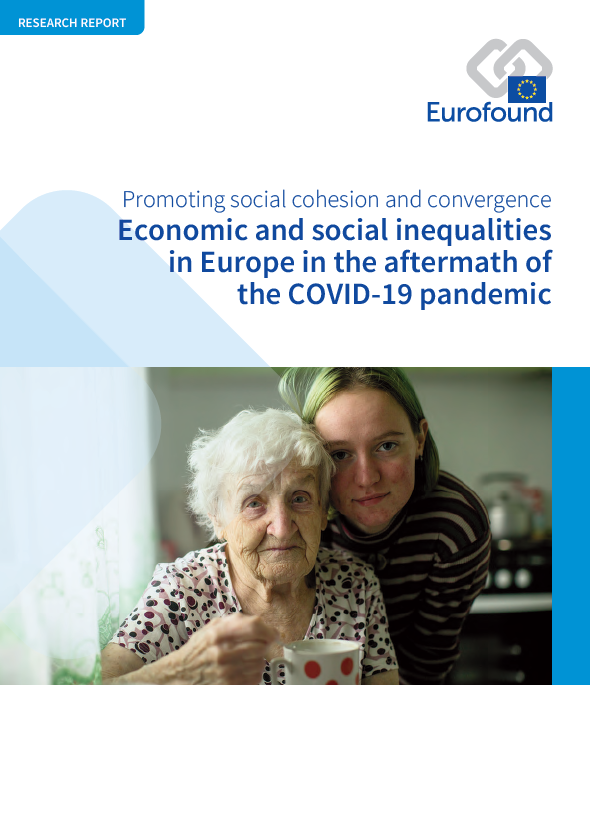
Covid-19-pandemin fick olika konsekvenser för olika samhällsgrupper, beroende på befintliga skillnader i förutsättningar, och det har allmänt ansetts att den ledde till att ojämlikheten ökade på olika områden i livet. Med hjälp av indikatorer från EU:s ram för övervakning av flerdimensionella ojämlikheter visar denna rapport hur ojämlikheten i fråga om inkomst, hälsa, sysselsättning och utbildning förändrades mellan 2010 och 2020. I rapporten undersöks också de viktigaste drivkrafterna för denna förändring under pandemin, liksom förhållandet mellan den statliga politiken på flera områden och ojämlikheten.
Key findings
Under det första året av covid-19-krisen fortsatte inkomstskillnaderna att minska, vilket bekräftade att det skett en utjämning av ojämlikheten inom EU. Arbetssökande och personer med låg och medelhög utbildningsnivå löpte dock höge risk för att få minskad inkomst under pandemin. Även om inkomstskillnaderna kanske inte ökade överlag under covid-19 är det därför viktigt att beslutsfattarna noga bevakar detta område under den rådande levnadskostnadskrisen.
Det finns ett starkt samband mellan ojämlikhet i hälsa och inkomst: funktionsnedsättningar är nästan tre gånger så vanliga i den lägsta inkomstkvintilen som bland de 20 procent som har högst inkomst. Under pandemin ökade också den inkomstrelaterade ojämlikheten i tillgång till hälso- och sjukvård: under 2020 var risken att inte få ett medicinskt behov tillgodosett 5,4 gånger så hög för personer i den lägsta inkomstkvintilen som för de 20 procent som hade högst inkomst. Detta visar hur politik som inriktar sig på att minska ojämlikheten i inkomst också kan minska ojämlikheten i hälsa.
Enligt forskningsresultaten kan arbetet hemifrån under pandemin ha lett till ojämlikhet mellan låg- och höginkomsttagare, och de som är mest sårbara för kriser är visstidsanställda, unga människor och personer med otrygga anställningar. För att denna tendens inte ska bestå i det allt mer flexibla arbetslivet efter covid är det avgörande att beslutsfattarna tar itu med otrygga anställningar och ökar tydligheten och förutsägbarheten i arbetsvillkoren.
Under pandemin hade tillgången till lämplig utrustning för att delta i nätbaserad utbildning större betydelse än inkomst, vilket framhäver vikten av att ta itu med den digitala klyftan och ge alla tillgång till teknik på lång sikt. Föräldrar och studerande som bodde på landsbygden och inte behövde pendla under denna period var också överlag mer nöjda med kvaliteten på den nätbaserade utbildningen än de som bodde i städer.
Möjligheten att arbeta hemifrån ledde till ojämlikhet mellan låg- och höginkomsttagare och förstärkte ojämställdheten mellan könen när det gällde barnomsorg och hushållsarbete. Under 2020 var ensamstående mödrar den grupp som oftast gick ner i arbetstid på grund av stängning av skolor och barnomsorgsinrättningar. Om kvinnor fortsätter att ägna mer tid åt obetalt arbete än män kan detta komma att öka löneklyftan mellan könen under återhämtningen.
The report contains the following lists of tables and figures.
List of tables
Table 1: Indicators selected for the income inequality analysis
Table 2: OLS regression model exploring the relationship between government spending and inequality in making ends meet according to education level
Table 3: Panel OLS regression exploring general drivers of income inequality (1995–2020), EU27
Table 4: OLS regression model exploring drivers of income inequality between rural and urban households
Table 5: OLS regression model exploring income inequality by individual characteristics
Table 6: Logistic regressions on income inequality by individual characteristics
Table 7: Indicators selected for the health inequality analysis
Table 8: OLS regression model exploring the relationship between government expenditure and inequality in chronic disease
Table 9: Multilevel logit regression model on worsening health between 2019 and 2020
Table 10: Multilevel logit regression models on worsening health and mental health between 2019 and 2020
Table 11: Indicators selected for the employment inequality analysis
Table 12: OLS regression model exploring the relationship between government expenditure and inequality in opportunity in having a white-collar job
Table 13: OLS regression model exploring the relationship between gender inequality in occupations, childcare and paid leave at country level
Table 14: OLS regression model exploring the relationship between gender inequality in being employed, childcare and paid leave at country level
Table 15: Random effects within–between model showing the relationship between gender inequality in employment, over time and between countries
Table 16: Multilevel linear regression model on the number of hours worked in 2019 and 2020
Table 17: Multilevel linear regression model on the change in the number of hours worked between 2018 and 2019 and between 2019 and 2020
Table 18: Indicators selected for inequality in education analysis
Table 19: OLS regression model exploring the relationship between government spending and inequality in PISA scores
Table 20: Determinants of respondents’ satisfaction with the quality of their children’s online schooling (multilevel ordered logit model)
List of figures
Figure 1: Dimensions of life of the EU MIMF
Figure 2: Intersectional approach to effects of COVID-19 on inequality
Figure 3: Macro-, meso- and micro-level factors in income inequality during the COVID-19 pandemic
Figure 4: Heatmap showing the results of income inequality indicators by country, 2018–2019, EU27 and the UK
Figure 5: Income quintile share ratio (S80/S20) for equivalised disposable income, EU27
Figure 6: Gini coefficient of equivalised disposable income, EU27, Bulgaria, Greece and Poland
Figure 7: Odds ratio of a household having problems making ends meet (with versus without a tertiary education, 2018) against spending on education (2015, % of GDP), EU27 and the UK
Figure 8: Odds ratio of a household having problems making ends meet (with versus without a tertiary education, 2018) against spending on social protection (2015, % of GDP), EU27 and the UK
Figure 9: Scatterplot of government spending on social protection (% of GDP at time t–1) relative to the Gini index of disposable income at time t (1995–2020), EU27
Figure 10: Odds ratio of households having problems making ends meet (rural versus urban, 2018) against public investments in agricultural R&D (2015, % of GDP), EU27 and the UK
Figure 11: Households that reported that their income decreased in 2020 compared with the previous year by country (%), selected Member States
Figure 12: Households containing people aged 50+ that received financial support from the government due to the pandemic by country (%), selected European countries
Figure 13: Recipients of pandemic-related government support by country, EU27 (%)
Figure 14: Macro-, meso- and micro-level factors in health inequality during the COVID-19 pandemic
Figure 15: Heatmap presenting the results of health inequality indicators, 2018–2019, EU27 and the UK
Figure 16: Map of odds ratios of people reporting unmet medical care needs (women versus men, adjusted), 2018
Figure 17: Heatmap of odds ratio of feeling depressed for different social groups, 2018–2019, EU27 and the UK
Figure 18: Risk ratios of having a severe long-standing limitation in usual activities (disability) due to a health problem for various social groups (2010–2020), EU27
Figure 19: Risk ratios of having an unmet medical need due to high cost, distance to travel or waiting lists for various social groups (2010–2020), EU27
Figure 20: Government spending on education in 2002 (% of GDP) relative to ex ante inequality of opportunity in having two or more chronic diseases in 2019 (aged 50+), EU27
Figure 21: Macro-, meso- and micro-level factors in inequality in working life outcomes during the COVID-19 pandemic
Figure 22: Heatmap showing results of working life inequality indicators, 2018–2019, EU27 and the UK
Figure 23: Risk ratios of gender inequality in various dimensions of working life (2002–2020), EU27
Figure 24: Risk ratios of unemployment rates among various social groups (2002–2020), EU27
Figure 25: Risk ratios of employment rates among various social groups (2002–2020), EU27
Figure 26: Odds ratio of women being in employment versus men (2019) against the share of children under three years of age in formal childcare (2019, %), EU27
Figure 27: Average number of weekly hours worked in 2020 by country and contract type, selected EU Member States
Figure 28: Proportion of women who held second or third jobs by household type, 2020 (%)
Figure 29: Macro-, meso- and micro-level factors in inequality in education and learning during the COVID-19 pandemic
Figure 30: Heatmap showing results of education inequality indicators, 2018–2019, EU27 and the UK
Figure 31: Difference in tertiary education attainment as a whole in 55- to 74-year-olds and those with parents with a lower than tertiary education (2021)
Figure 32: Trends regarding inequality in education between women and men (2002–2020), EU27
Figure 33: Risk and odds ratios of NEET rates between various social groups (2004–2020), EU27
Figure 34: Government spending on education (2013, % of GDP) against P90/P10 PISA scores in mathematics (2018), EU27 and the UK
Figure 35: Parents’ satisfaction with the quality of online schooling for their children, EU27 (%)
Figure 36: Parents’ satisfaction with the quality of their children’s online schooling depending on whether they worked from home or not during the pandemic, EU27 (%)
- Number of pages
-
102
- Reference nº
-
EF22002
- ISBN
-
978-92-897-2309-1
- Catalogue nº
-
TJ-07-23-019-EN-N
- DOI
-
10.2806/439913
- Permalink
Cite this publication
Eurofound (2023), Economic and social inequalities in Europe in the aftermath of the COVID-19 pandemic, Publications Office of the European Union, Luxembourg.
